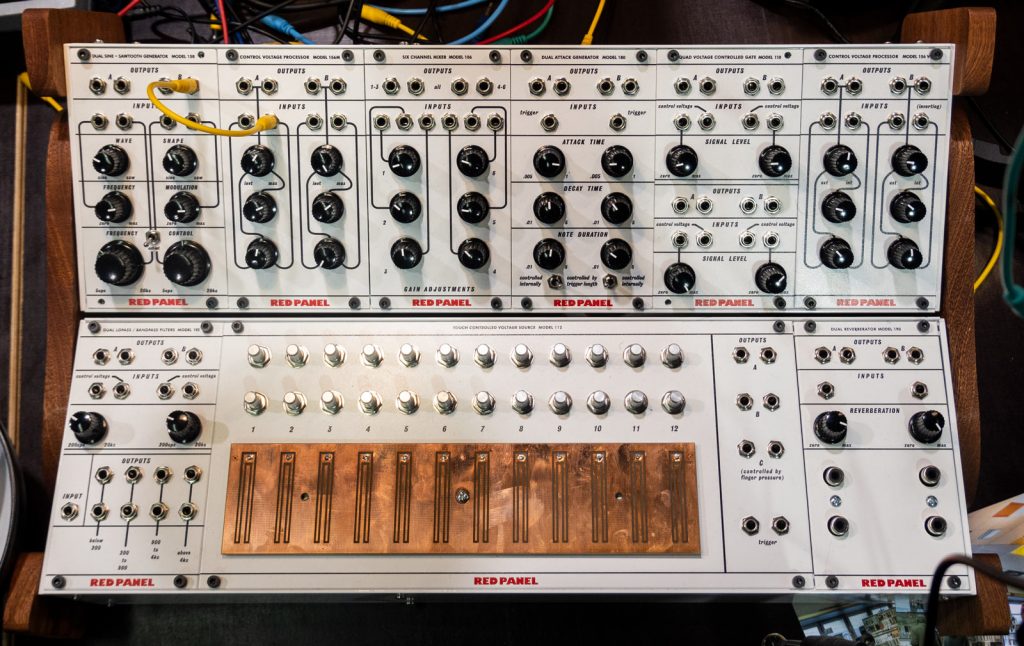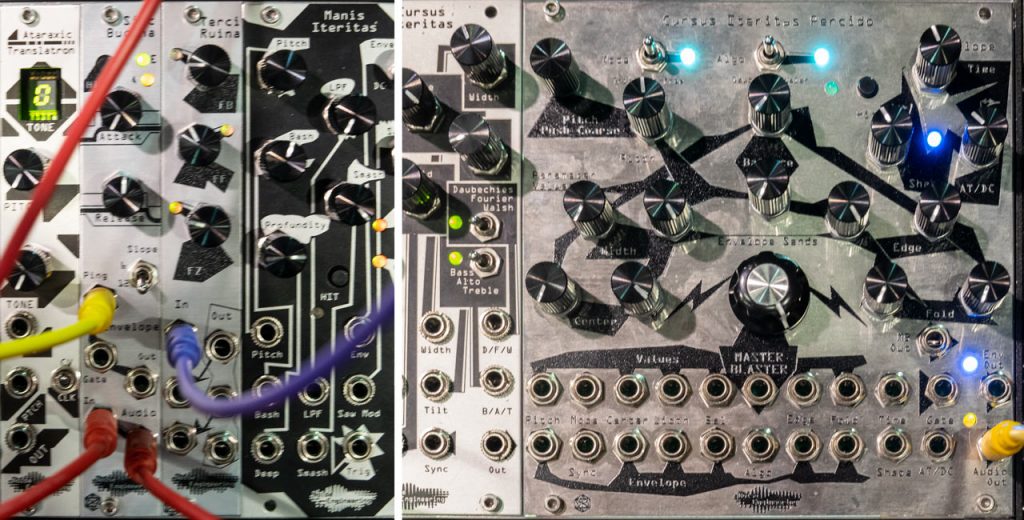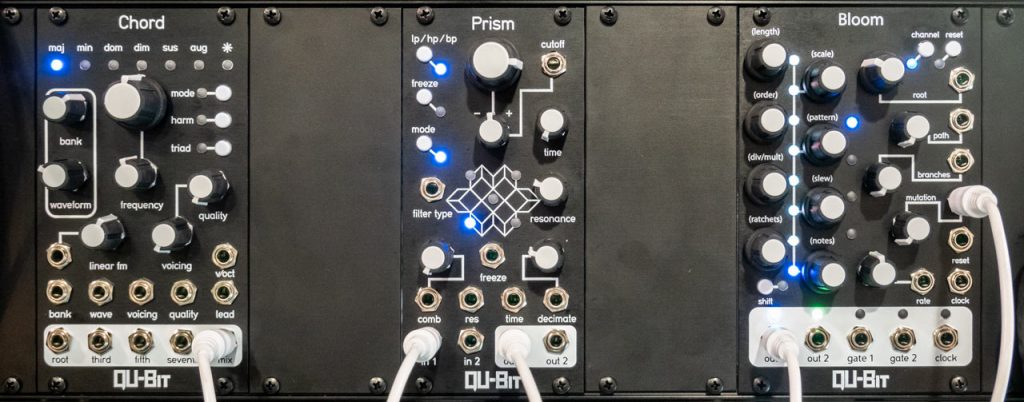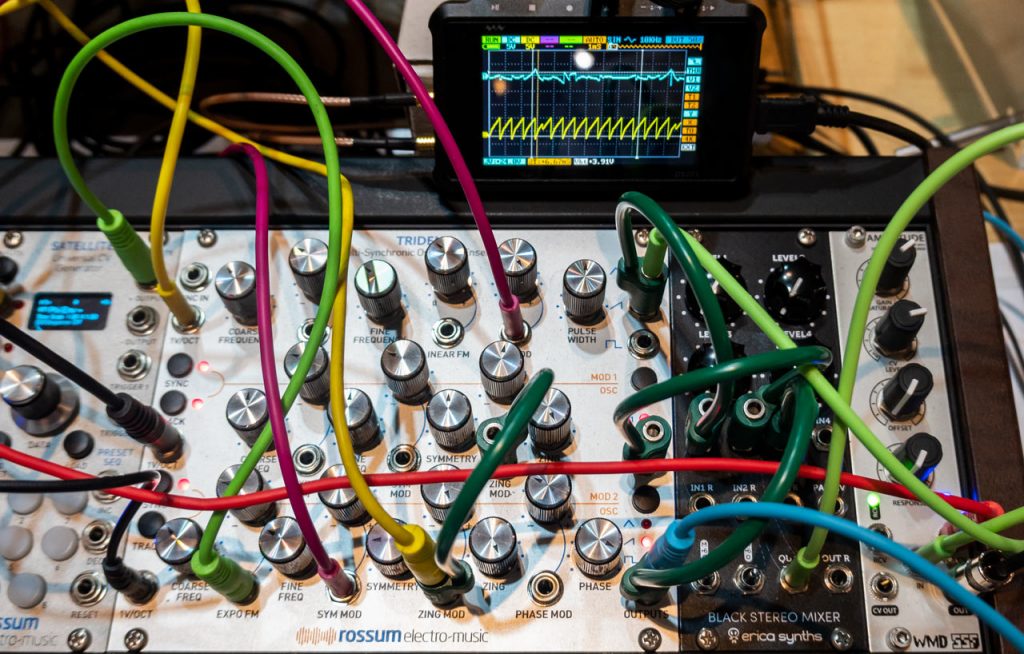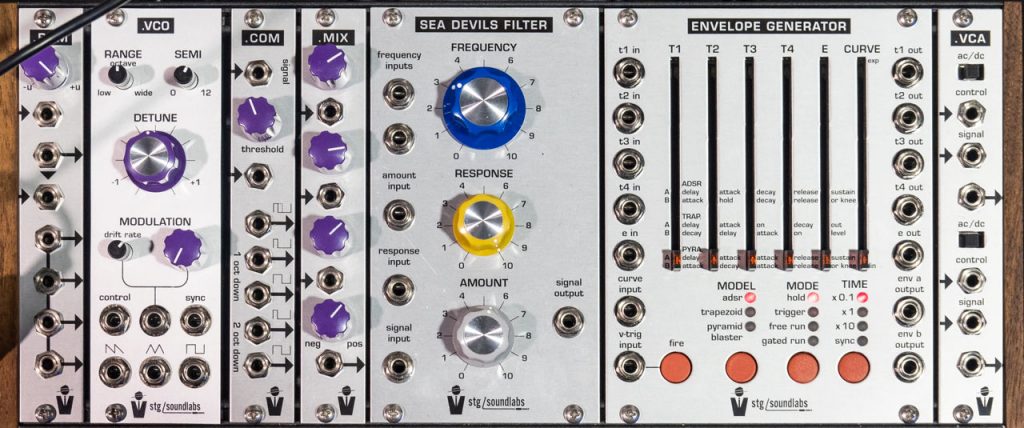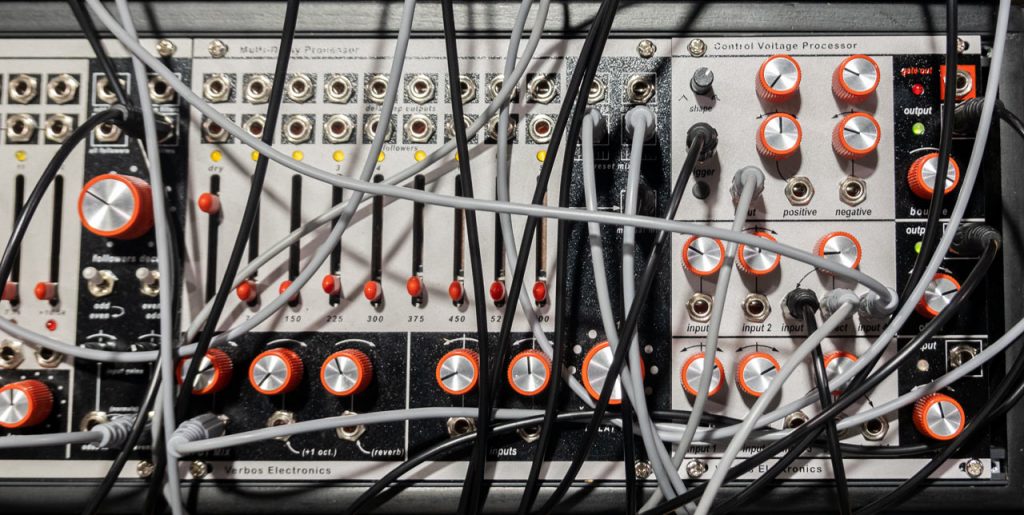For a variety of reasons, far fewer modular manufacturers chose to exhibit at NAMM this year. This meant it was possible to spend more time playing, talking about, and listening to the gear that was at the show. Here is a summary of what I saw, with a focus on interesting developments and stories:
2hp
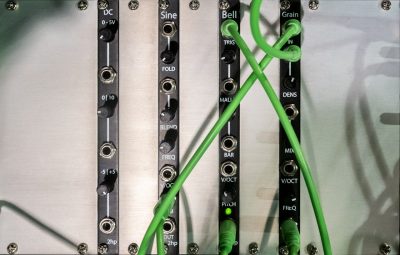 2hp released a set of new modules, including the utility module DC that contains a set of three bias voltage outputs. The other three are sound generators:
2hp released a set of new modules, including the utility module DC that contains a set of three bias voltage outputs. The other three are sound generators:
- Sine, which contains a digitally generated sine wave plus a “sub” that can be one octave below or a fifth above the main output. It is very hard to create a pure sine wave with analog circuitry; digital sines tend to be more pure, if you’re looking for a clean modulator for an FM pair. It also contains a wavefolder.
- Bell, which is a nice struck-side complement to their Pluck module that I like a lot. It creates a nice range of focused sounds, with adjustable and CV-able Mallet and bar settings.
- Grain, which is a simple real-time granular processor/delay with adjustable Density plus a four-octave pitch offset for the grains.
Time for a little editorializing: I like granular processors…but I miss that none of them today can replicate the functionality of a piece of Mac OS9 freeware from the 1990s called thOnk. thOnk slowly worked its way back and forth through a source file, creating grains that varied in duration, spacing, and most importantly pitch, truly creating a “cloud” effect instead compared to the delay-gone-mad of most modern granular processors. These variables were fed internally by Brownian-like “drunken walk” random modulations so the output flowed from munchkins chattering to sustained demonic choirs. I created a public post on Patreon with an audio example of what it can do.
Buchla Red Panel
Buchla is taking over the manufacturing, marketing, and distribution of the Eurorack-format Buchla tribute modules released by Catalyst Audio, which are based on the original Buchla 100 series schematics. The Catalyst versions were all through-hole designs (with the exception of the 156M Control Voltage Processor), but these proved less than ideal to manufacture. David was already working on mostly surface mount versions of his existing modules (keeping through-hole for critical components, such as matched transistor pairs), plus a few new ones; Buchla picked those up and re-labeled them the Red Panel line (complete with Buchla 100-like knobs), and will work with David to create additional releases releases, focusing on other 100 series designs.
For those unfamiliar with the Catalyst modules, they include the 106 six channel mixer, 110 quad “gate” (VCA), 158 Dual Sine-Sawtooth Oscillator with manually variable waveshape, 180 Dual Attack generator (AHD shapes with adjustable “Note Duration” hold stages), and two versions of the 156 Control Voltage Processor: one based on the original Buchla circuit (V for Vintage), and one updated by David to work more “as expected” (M for Modern), meaning it has linear response, can deal with negative voltages, and has up to 1.5x gain. (More on that “linear” bit in a moment.)
Added to that were the previously-announced but not yet in production 112 Touch Controlled Voltage Source, 190 Dual Reverberator (spring reverb with external tank), 193 (Combination of 194 and 191) non-voltage-controlled Dual LoPass / Bandpass Filters, and a 6U 84HP case designed by Art for the Ears that is similar to the current Buchla Skylab boats. An interesting fact about the 112 touch controller (which does not have knobs in the photo – more about those below) is that it does not have an output per channel like a Serge TKB or the new Verbos Mini Horse; instead it has internal note priority to a specific channel, so you can “play” it similar to a keyboard. It uses Buchla’s original design for capacitive touch.
Noise Engineering
Noise Engineering introduced four new modules at NAMM:
- Fractio Solum, a clock divider/multiplier to complement their growing line of alternative sequencing modules
- Sinc Bucina, their version of a low pass gate (with switchable 6 or 12db/octave responses) with a built-in ASR envelope generator and pingable vactrol-like input
- Terci Ruina, a trio of simple distortion circuits available separately or in series in one module
- Cursus Iteritas Percido, which continues their idea of taking one of their three-algorithm digital oscillator modules and adding an envelope generator to create more of a percussive voice module
I had a nice chat with Stephen McCall of Noise Engineering about his intentions behind some of their new modules – namely, performability.
Take Terci Ruina. It places three simple guitar pedal fuzz circuits and in a Eurorack module, with one knob per circuit. When I asked Stephen if these should be treated as waveshapers or simple sound-obliteration circuits, he replied they should be treated as level-sensitive waveshapers: what you get out will vary greatly dependent on the level of the signal going into them. To get the most out of it, place a VCA before it, and adjust its level either with a performance controller such as the Touché, or vary it with a modulation source such as an envelope generator or an LFO.
Unlike the Terci Ruina with its three simple non-voltage-controlled knobs, most Noise Engineering modules are known for having a large number of modulation inputs; to get the most out of these modules, you need to feed them varying controls. The Percido line adds an envelope generator right inside the module, pre-routed to the different modulation destinations. The Percidos also have “Envelope Sends” where you can set different modulation depths per destination.
What Cursus Iteritas Percido brings new to the table is a “Master Blaster” control in the center of the module. This allows you to fade up or down those different sends with a single control. Stephen felt this made it easier to change the sound of individual notes, instead of expecting the user to change a bunch of parameters themselves at the same time (or more likely, set their modulation depths and forget them).
Qu-Bit Electronix
As you can see from the photo above, Qu-Bit has committed to black panels for all new modules, but they are also slimming down the width of some of their panels to take up a bit less room. For example, they showed a significant update to their Chord module that boasted “half the size – twice the functionality” including new wavetables, user-created chords, and the ability to access the oscillators individually.
Their new Prism stereo effects processor offers three effects, arranged in a virtual pyramid: a comb filter/delay on the X axis, a bit depth decimator and sample rate reducer on the Y axis, and a multimode filter on the Z axis that an be placed before or after the other effects. There is also a Freeze command to loop an audio buffer in front of all three effects.
Their most interesting new module for me was the Bloom Fractal Sequencer. The problem many have identified with algorithmically generated music is that quite often, it does not resolve back to an earlier theme, which is an important musical concept for our brains to latch onto and consider music to be “composed” rather than “random.” Bloom solves this problem by allowing its Mutation parameter to vary between the central theme or sequence you program and completely random notes. Bloom also allows you to set the pattern length, transpose it, and play with alternative notes and durations.
Rossum Electro-Music
After Dave Rossum released his Morpheus digital filter, I asked Dave when he was going to make an oscillator that created a lot of interesting harmonics to process through the Morpheus and his analog Evolution filters. As it turns out, I wasn’t the only person to ask him this question; his answer is the Trident triple VCO.
In short, the Trident contains one carrier oscillator (along the top), and two modulation oscillators (underneath). The carrier oscillator outputs triangle, sawtooth, and square waveforms, each fed through a pair of four-quadrant multipliers (also known as ring modulators). These multipliers are connected to the two modulation oscillators, with a special depth control that varies from outputting the carrier’s source at full level without modulation, to full ring modulation (normally, attenuating the modulation depth to a four-quadrant multiplier would reduce the level of the overall signal to silence). The main carrier oscillator also has separate linear (non through zero) and exponential FM inputs as well as pulse width modulation, and internally sends a sync signal to the two modulation oscillators.
Each modulation oscillator has a single output, switchable between triangle, sawtooth, and square. Voltage-controllable Symmetry bends the triangle from sawtooth through triangle to inverted sawtooth; it also adds a breakpoint or “kink” to the sawtooth and acts as a pulse width control. Each also features exponential FM, hard sync from the carrier oscillator, and voltage controlled modulation depth back to the carrier oscillator, named Zing. The second modulation oscillator also features voltage-controlled Phase that can delay when it synchronizes (resets its waveform) in relation to the carrier oscillator.
What is “Zing” modulation? Normally, ring modulation is associated with inharmonic, “clangorous” sounds, as it outputs the sum and difference of the not only the fundamental frequency of the carrier and modulation oscillators, but every combination of harmonics between the two. However, if the fundamental frequency is locked between the two by using sync, then all of the sum and difference combinations will have a tonal integer harmonic relationship to the carrier’s fundamental, with the final mix of harmonics being determined by the chosen waveshapes and their sync relationship.
STG Soundlabs
Suit & Tie Guy announced several items at NAMM, including the Radiophonic One system-in-a-case you see above. STG has long wanted to offer complete systems in both 5U and Euro; an oscillator has been the last component needed to make that happen. The VCO is a brand new design specified by STG and executed by William Matheson at WMD.
The new STG .vco is an analog design with a digital front end that enables some very nice features. One is a unique set of tuning controls. The Range control puts the VCO into LFO mode when full counterclockwise; when fully clockwise, it lets the Detune control sweep continuously through the full audible range. In between, it is quantized to choose octave offsets, and then the Detune control has a smooth range of +/-1 semitone. The Semi control is quantized to select semitones, with “fat” areas in its sweep around the root, fifth, and octave above for quick re-tuning.
The Modulation section is designed to introduce detuning that can go from subtle to extreme. An internal Brownian noise-like random source wanders between internally generated voltage targets with an S curve hand-drawn by Suit that smoothes out the turnarounds. This is attenuated by the range control, and used to offset the oscillator’s frequency. The internal modulation can be overridden with an external source. The output waveforms are sawtooth, triangle, and a square that is an octave down.
The Radiophonic One sits inside a converted Moog Mother-32 case. Remove the modules, and you’ll see that the Mother’s original power and audio circuit board have been replaced by a newly designed power bus board called the Boat Rocker. It takes an external +12v switching power supply, internally bumps it up in level, and then uses new-generation LDO power regulators with high ripple (noise) rejection to create a clean 1 amp on the +12, -12, and +5 volt rails. The two banks of six power connectors come on in sequence to avoid problems with a module that has a high “inrush” (startup) power demand – like tube modules, and others with large capacitors (more on that in a future report) – from over-taxing the system.
Additionally, the headphone jack on the back of the Mother’s case is repurposed to be a DIN Sync in. This is distributed to a set of STG Sync connectors that can synchronize several different STG modules, including their envelope generator in the Radiophonic One.
Several companies and individuals have been playing with a technique of taking two (or more) waveforms, slicing them up time-wise, and splicing them back together to create new waveforms. Examples include the Befaco Chopping Kinky, the Dove Audio WTF, MOK Waverazor Dual, and the demo Jon Sonnenberg gave at Knobcon 2018 of patching it on a 5U modular system. Jon has been working on creating the .slc Eurorack module that embodies his version of this technique, to be distributed by STG. Unfortunately, it wasn’t fully functional, but it showed potential.
Verbos Electronics
Verbos showed two new modules: a Control Voltage Processor, and the Mini Horse touch controller.
The Control Voltage Processor contains multiple functions in one module. Each of the two bottom sections contains two inputs with attenuverters (from -100% to +100% of the signal’s original level), a voltage controlled crossfader (that can also be used as a normal or inverse-action VCA), and a DC bias offset to add to the mix of those inputs.
The top section is a positive and negative slew or slope generator – like one channel of a Serge universal slope generator, but with some important differences. One is that the linear through exponential Shape control is based on an “RC” capacitor curve. This means it has a “normal” East Coast logarithmic attack and exponential decay for envelope generator duties, rather than the inverted attack shape for exponential decays of many West Coast function generators. Also, the envelope time stays somewhat consistent as you change the Shape, in contrast to CV feedback-based circuits have wide swings in their cycle times as you change the shape. You have separate control over the positive and negative slew (rise and fall times). Also, the Gate output goes high when the output voltage gets near zero. Patch this gate into the signal Input, and this section will loop like an LFO.
The most interesting feature for me is the Bounce control. Mark Verbos found a way to create a “bounce” or ringing circuit that just overshoots the attack without slowing it down, plus controls the undershoot, creating a fun bounce, doubled attack, or “wobble” in the output voltage.
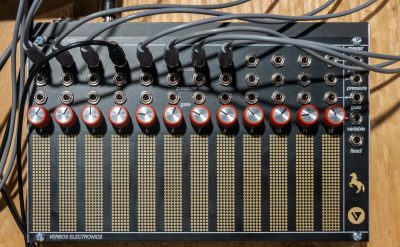
In addition, each touch surface has its own gate output, as well as a potentiometer to set a custom output voltage for that surface. A Master section to the right outputs the position, pressure, gate, and variable knob value for the most recently touched surface; there is also a “fixed” output that is a 0-10v level scaled by which surface you last pressed from left to right, acting as an “x direction” positional value.
The Mini Horse fits into a standard Eurorack case (42 hp wide); Verbos is also creating an “ultra low profile” Black Box powered enclosure for it so you can use it outside of your case. (The enclosure at NAMM was simple bent and cut aluminum; the final Black Box enclosures will be much higher quality.)


